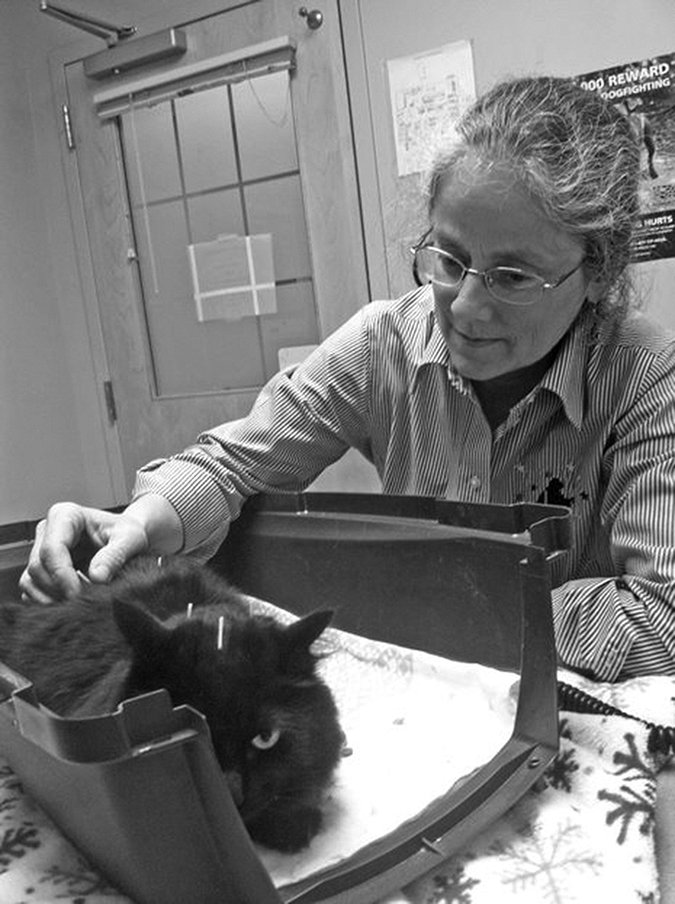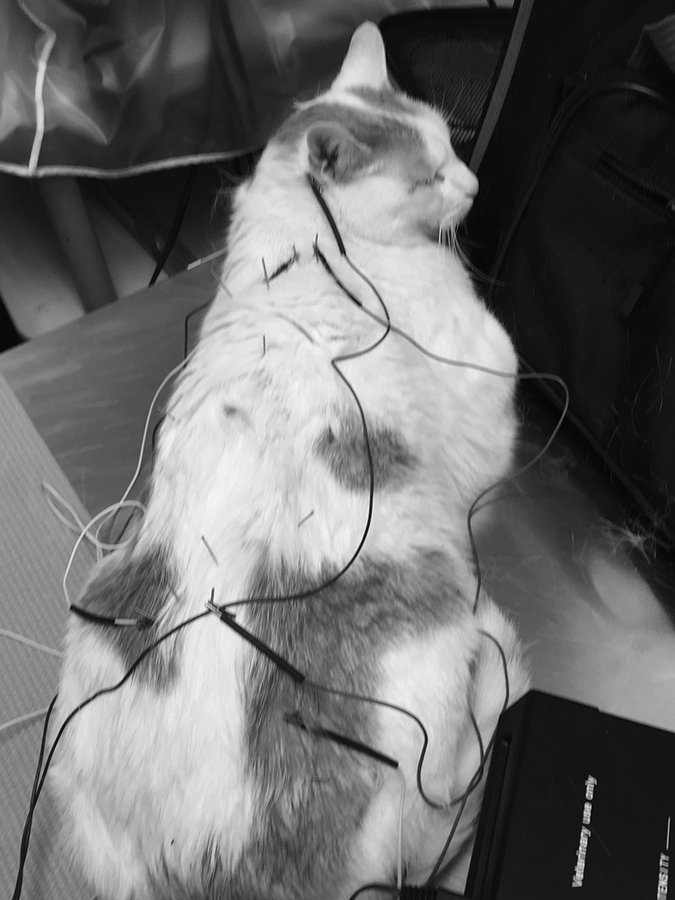Dusty was a black and white cat who hissed, swatted and squirmed anytime a veterinarian or technician tried to restrain her for an examination or, worse, tried to draw blood or give an injection. This same cat, however, transformed into a picture of serenity and calm during acupuncture treatments.
“The big surprise is just how many cats will sit still and accept acupuncture needles,” says Polly Fleckenstein, DVM, MS, a Cornell graduate at the Veterinary Medical Center of Central New York, who is certified in veterinary acupuncture.
Acupuncture Can Stop Seizures
“Dusty was my cat. She suffered from seizures and hated being handled. But once we added acupuncture to her care after a long trial with anti-convulsant therapy, she stopped having seizures,” says Dr. Fleckenstein, who is also certified in veterinary spinal manipulative therapy and pain management and trained in herbal therapy. “She never reacted negatively to the acupuncture needles and sat quietly in my husband’s lap for her treatments.”
Acupuncture is a 3,000-year-old Chinese healing art fast becoming a popular therapy for use on 21st-century cats, dogs, horses, even birds. Studies suggest that acupuncture may boost blood circulation and spur the release of pain-controlling endorphins and anti-inflammatory hormones.
Dr. Fleckenstein has incorporated acupuncture in her practice for two decades. She believes that pet owners are seeing the benefits of integrative medicine for themselves and want the same type of care for their pets. “More owners are willing to do more for their pets in terms of medicine, pain management and nutrition,” she says. “They are looking for that extra little bit that may improve the quality of life for their pets, and acupuncture is a viable option.”
The most recognized type of acupuncture involves tiny needles inserted strategically at acupuncture points located throughout the body on meridans. Meridians, or channels, are a network of pathways where energy known as Qi is believed to flow in traditional Chinese medicine.
Polly Fleckenstein

Some Acupuncture Risks
There are some risks to consider with the therapy — the most serious is swallowing a needle. “I’ve inserted over 100,000 needles and I’ve never had a cat do it. One dog has swallowed one needle,” Dr. Fleckenstein says. “Fortunately, the needle passed harmlessly.”
In addition, needle insertion could cause pain or a small amount of bleeding and rarely an infection at the site. The needles are sterile and single use. Many feline patients relax and fall asleep during treatment that ranges in duration from a few minutes to a half hour.
Joseph Wakshlag, DVM, Ph.D., chief of the Sports Medicine and Rehabilitation Service at Cornell, who is certified in acupuncture and board-certified in veterinary sports medicine and rehabilitation, believes acupuncture should be mainstreamed. “Using the word complementary is now a bit of a misconception. I have no stats on the number of veterinarians who are certified in acupuncture, but if Ithaca (N.Y.) is a measure, we have seven in our area now.” He and neurologist Curtis Dewey, DVM, offer acupuncture therapy for cats at Cornell.
Fewer Studies
The American Academy of Veterinary Acupuncture, which has seen an increase in enrollment in training programs since the mid-1990s, was recently admitted to the American Veterinary Medical Association’s House of Delegates. At least half a dozen veterinary schools teach acupuncture, but while the therapy represents a growing practice among veterinarians and numerous studies have shown its effectiveness in certain human applications, significantly fewer studies have been done on dogs and cats.
Meanwhile, anecdotal reports about the successful use of acupuncture therapy in animals continue to grow. Acupuncture can be combined with medicines and other treatments with no known side effects. It’s used to stimulate the body to heal itself through a variety of proposed mechanisms and may benefit cats with:
– Arthritis, sore muscles and joints
– Muscle spasms
– Paralysis
– Digestive problems, including constipation, diarrhea and vomiting
– Diabetes
– Heart disease
– Kidney disease and lower urinary tract disease
– Asthma and other respiratory problems
– Seizures
– Weakened immune system
– Cancer — Acupuncture can provide pain control, improve white blood cell counts and immune system function, and help control chemotherapy-induced nausea and anorexia, says Dr. Fleckenstein.
DVM

“I’ve had some paralyzed cats whose mobility has improved, and I treated a cat who had kidney disease for about five years,” Dr. Fleckenstein says. “After regular acupuncture treatments, his kidney function returned to normal. We can’t prove that acupuncture was responsible for the improvement, but we did not change anything else in our treatment.”
To maximize the benefit of acupuncture, the cat is treated in a quiet room with dimmed lighting. Some cats prefer napping on a towel or blanket on the exam table while others seek comfort inside a large box on the floor next to their owners. “Owners need to relax as much as possible because their cats react to their energies or anxiety,” says Dr. Fleckenstein. “Depending on the patient, we may turn on music and the water fountain and may use a feline pheromone.”
Acupuncture Sessions Vary
The number of recommended acupuncture treatments depends on the cat, but these are initially administered weekly, with the goal of extending to maintenance visits every month to six weeks, or as needed. Some pet owners may note that their pet does better with more frequent treatments and they may come in more often.
The cost ranges between $70 and $150 per treatment. Acupuncture may qualify for pet insurance, but coverage varies. A check of five pet insurance companies found that one company covers acupuncture if it’s performed by a licensed veterinarian for a covered accident or illness, but excludes acupuncture as preventive or routine care. Another company requires the owner to purchase additional coverage for acupuncture reimbursement, and still another allows it as a wellness benefit.
“While acupuncture is not a panacea, it may be beneficial for some of our feline friends,” Dr. Fleckenstein says. “You may find that it is a great alternative or addition to other forms of treatment. Cats sometimes have limited options for medications due to their metabolism and propensity for adverse reactions — think anti-inflammatory medications — not to mention the potential difficulty of administering pills to a cantankerous cat or a ferocious feline!”
While still the source of controversy and in its relative infancy with respect to scientific investigation compared to other, more widely accepted therapies in conventional medicine, acupuncture warrants further investigation and may very well prove to be an important therapeutic option for a wide variety of feline diseases.



